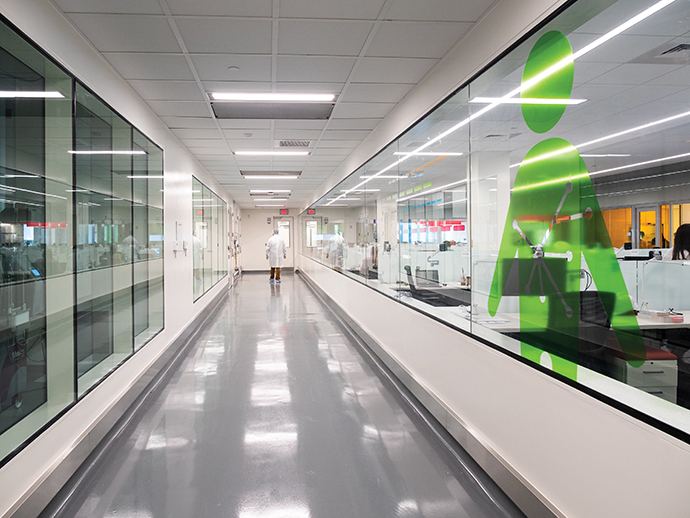CBRE’s “2019 U.S. Life Sciences Clusters: Markets Positioned for ‘Century of Biology’ ” report, published earlier this year, finds that three of the top 10 regions for the sector are in California: No. 2 San Francisco Bay, No. 3 San Diego and No. 9 Los Angeles. Can the state take some credit?
“Yes, you can credit the state,” says Ian Anderson, director of research and analysis for CBRE and director of life sciences research for the Americas. You can also credit the power of association — as in the California Life Sciences Association. A strong industry organization — like MassBio supporting No. 1 Boston-Cambridge in Massachusetts — “is very important to keeping some of these companies, and keeping them flourishing and maintaining that economic base.”
Indeed, the strong keep getting stronger. California’s life sciences sector alone employs more than 311,000 Californians at 3,400 life sciences organizations. The strong clusters also feature another crucial layer of support from the venture capital community, still heavily concentrated in the Bay Area and metro Boston.
“The amount of new venture capital to the life sciences industry over the past year has been staggering,” says the CBRE report, with most of it going to biotech. “Since the plentiful capital also correlates to future job growth in the industry, stronger hiring and demand for commercial real estate should occur over the next year. Most of this funding is being allocated to companies in Massachusetts and California (74%), but that share has dropped over the past two years as investors seek companies in new markets.”
Leading that pack of new regions is the Washington, D.C.-Baltimore market, which has seen venture capital funding jump by nearly ninefold within the past 18 months, says CBRE. “Philadelphia, Chicago, Raleigh- Durham and San Diego also had impressive gains in attracting venture capital over the past 18 months.”
Anderson says cities like Pittsburgh, Tucson and Ann Arbor can also be included in that mix, due to “so much innovation and so many new discoveries happening in a lot of research institutions throughout the country,” namely places such as Carnegie Mellon, University of Arizona and University of Michigan. “Boston and San Francisco are the center of activity, but there is so much going on, the venture capitalists are starting to spread out.”
Asked about “near-miss” markets just outside the report’s lists, Anderson mentions the Ohio cities of Cleveland, Cincinnati and Columbus, where great institutions and strong services infrastructure simply need to gain further traction. Phoenix, Minneapolis, Dallas and Atlanta fall into that next group too.
“They have the talent and some life sciences or life-sciences-related institutions,” he says, “but for the money and services and NIH funding and some of the biotech talent, those metros are a bit behind.” Minneapolis is really heavy in medical devices. Dallas has the tech talent. Atlanta is seeing some rapid growth. “But they miss on the NIH funding and a strong research university to support it,” he says (notwithstanding the bona fides of Georgia Tech, Emory University or the University of Minnesota).
The Boston-Cambridge market once again attracted the nation’s largest amount of funding from the National Institutes of Health (NIH) in 2018 at approximately $2.4 billion, says the CBRE report. “Nonetheless, New York City, the second largest recipient of funds ($1.9 billion), is growing faster,” it says. “Over the past 10 years, the amount of funding to New York City institutions grew by 52%, the fastest of any of the top 20 largest markets and far faster than the 26% increase for Boston-Cambridge institutions.”
Anderson says one reason Boston and the Bay Area established and maintain their competitive edge is that the research institutions in those regions — MIT, UCSF, Stanford, UC-Berkeley and others — historically have had a culture inclined toward commercialization of their discoveries. “So they’ve been on the cutting edge, for the most part,” he says. Institutions in some other areas with people equally as talented and infrastructure equally as strong have historically chosen to keep commercialization at arm’s length. But they’re coming around.


“Now we’re seeing other institutions getting on board, with money to be made,” he says, highlighting his home market of Greater Philadelphia. “The University of Pennsylvania has probably been a little bit behind on this, but has started to shift. They just created a seed fund of about $50 million to go into startups, and that has absolutely helped spark private industry growth,” including one firm actually named Spark Therapeutics that was just bought out by Roche. “If Penn gets on that, then you get some of the local VCs and attract a whole other host of capital,” he says.
The report notes that Spark emerged from labs at Children’s Hospital of Philadelphia “and has become a significant source of demand for Class A office and lab space in Downtown Philadelphia. Another similar success story can be seen in Kite Pharma, a startup that originated out of the University of California, Los Angeles, and has grown to be a significant office and lab occupier in Los Angeles.”
One more trend? The influence of tech companies, which led CBRE’s thought leaders to observe that the emerging life sciences clusters possess “a sizeable high-tech workforce to support future convergence between the industries.” Anderson says it’s an interesting trend coming closer to reality, embodied in things like Google’s offshoot Verily.
“You have these large tech companies starting to venture into the life sciences space because they see the long runway.” Convergences that on the surface might seem odd — fashion companies wanting to make attire out of plant matter in New York City, say, or manufacturers with environmental concerns that a biological solution might resolve — will start to appear more de rigeuur as time goes by.
The tech/biotech convergence also is arising from a more mundane detail, says Anderson. “More of the life sciences workers are doing more of their work on computers, and less in the actual lab.”
Findings Highlight VC & R&D Links
Following are lightly edited and excerpted findings from the CBRE report. For more, visit www.cbre.com/research:
The nation’s leading life sciences clusters are identified by several criteria: laboratory inventory size, number and concentration of industry scientists, NIH and venture capital funding and long-term growth of the life sciences workforce. Each of these factors was standardized, allowing CBRE to compare markets against one another and showing Boston-Cambridge and the San Francisco Bay Area leading by a comfortable margin in terms of a sizeable, dynamic life sciences market poised for growth.
A second tier of markets includes the life sciences clusters of San Diego, Raleigh-Durham, New Jersey and Washington, D.C.- Baltimore. A third tier of markets exhibits various sources of strength, ranging from an attractive industry size and momentum in New York City and Los Angeles to a historical preeminence in the industry in Chicago and Philadelphia … CBRE’s analysis suggests Boston-Cambridge and the San Francisco Bay Area will continue their lead. However, significant momentum, especially in New York City and Los Angeles, implies these markets will play a greater role in the industry.
Rapid growth in the industry is spreading to new markets across the country. The markets emerging as prime candidates to become leading life sciences hubs exhibit an attractive combination of a substantive life science workforce, including key scientists, strong recent life sciences employment growth, ample NIH funding, top-ranked schools and medical institutions, and a sizeable high-tech workforce to support future convergence between the industries.
The U.S. life sciences industry is growing at the fastest pace since 2000. The 3.2% year-over-year growth rate in U.S. life sciences employment ending Q3 2018 is a strong acceleration from the slow, but temporary, growth in early 2017 and well-above the 1.7% increase in total U.S. nonfarm employment over the same period. Employment in the industry has grown 42% over the past 20 years … Biotech R&D has grown 88% over the past 20 years.
In 2018, the life sciences sector generated total annual revenue of $177.1 billion in California.
An abundance of capital allocated to the life sciences industry is helping fuel strong growth. The $15.8 billion in annual life sciences venture capital funding through Q3 2018 was an 86% increase from the prior year … The relationship between life sciences venture capital funding and employment growth is quite strong. New venture capital funding to the industry precedes increases in employment by about one year. Based on the recent surge in funding, employment should continue growing over the next year, supporting commercial real estate demand.
Current and anticipated life sciences employment growth is supporting ongoing construction of laboratory space in most markets. In the top-five life sciences markets, the amount of lab space under construction has jumped 101% in 2018. Though the 6 million sq. ft. of lab space under construction is still a relatively small percentage of total office space under construction in these markets, the influence of labs on supply-and-demand dynamics is growing. Through Q3 2018 in the San Francisco Bay Area, 26% of all office demand came from life science tenants, but only 16% of current construction is lab space.
Talent Search
Finding the best talent in today’s market is challenging. Focusing on the top 10 largest markets, the data show the life sciences industry is highly concentrated in two main regions: the Northeast Corridor stretching from Boston-Cambridge to Washington, D.C., and California.
Most of the growth over the past three years has occurred in smaller life sciences markets like Seattle, Houston, St. Louis and Dallas/ Ft. Worth. Nonetheless, these markets, which are a fraction of the size of Boston-Cambridge and the San Francisco Bay Area, have comparable recent growth, reflecting their remarkable strength.
Top 10 Leading Life Sciences Markets
- Boston-Cambridge
- San Francisco Bay Area
- San Diego
- New Jersey
- Raleigh-Durham
- Washington, D.C.-Baltimore
- New York City (and surrounding areas)
- Philadelphia
- Los Angeles
- Chicago
Top-Ranked Emerging Life Sciences Clusters
- Seattle
- Houston
- Austin
- Minneapolis
- St. Louis
- Dallas/Ft. Worth
- Atlanta
- Pittsburgh
Analysis of where key scientists — such as biomedical engineers, biochemists, biophysicists and chemists — are located reveals that not only is the talent more concentrated in the Northeast Corridor, but especially so in New York City and New Jersey. On the West Coast, the San Francisco Bay Area is the clear locus of talent for key scientists fueling innovation in the industry.
CBRE evaluates and ranks markets by various factors, including the size of the talent pool they produce, the level of expertise and sophistication in the graduates they produce (number of Ph.D.s), and the quality of academic institutions (as ranked by U.S. News & World Report). By these measures, many of the usual suspects rise to the top of the rankings: Northeast Corridor markets, California and Raleigh-Durham.
However, some major markets with smaller presence of the life sciences industry are creating a surprising amount of new talent each year, including Atlanta, Dallas/Ft. Worth, Sacramento and Pittsburgh. At the same time, some tertiary markets that are dominated by a major university have an impressive supply of talent, but only a minor life sciences presence. These markets include Ann Arbor, Michigan; Madison, Wisconsin and Columbus, Ohio.
This ranking, though helpful in evaluating markets on a broad basis for talent, obscures some significant sources of talent that can have a major impact on local market demand for lab space and industry presence. For example, the single greatest source of graduates in biomedical and biological sciences graduates in the nation, by a wide margin, is the University of California at San Diego.
Notably, the top three schools are in California: University of California-Davis, University of California-Los Angeles and University of California-San Diego. Not one of the top 10 schools producing total graduates in biomedical and biological sciences is located along the Northeast Corridor.
Finally, new sources of talent emerge that are far from traditional hubs of the industry, including in Tampa, Gainesville and Tucson.

